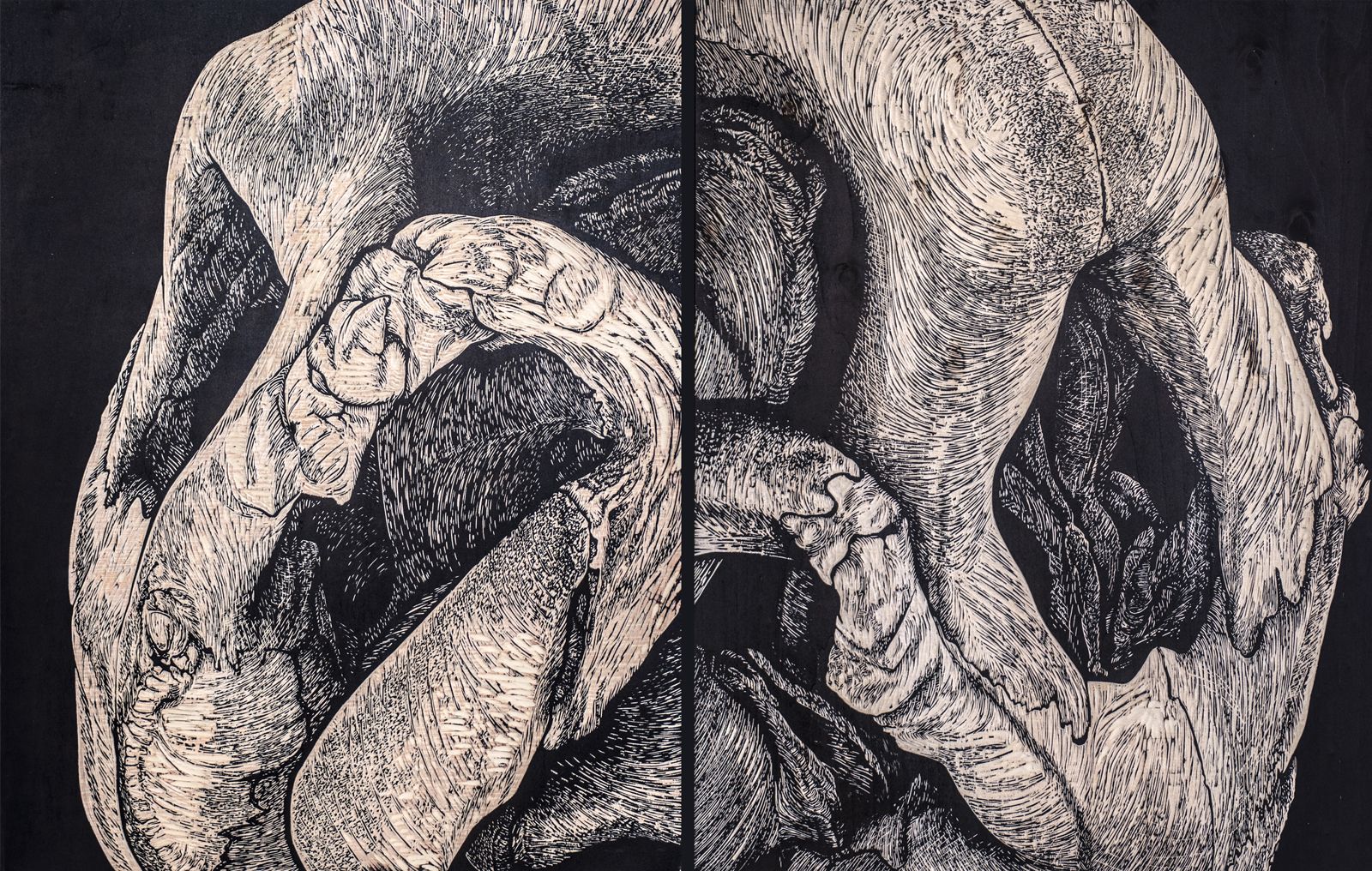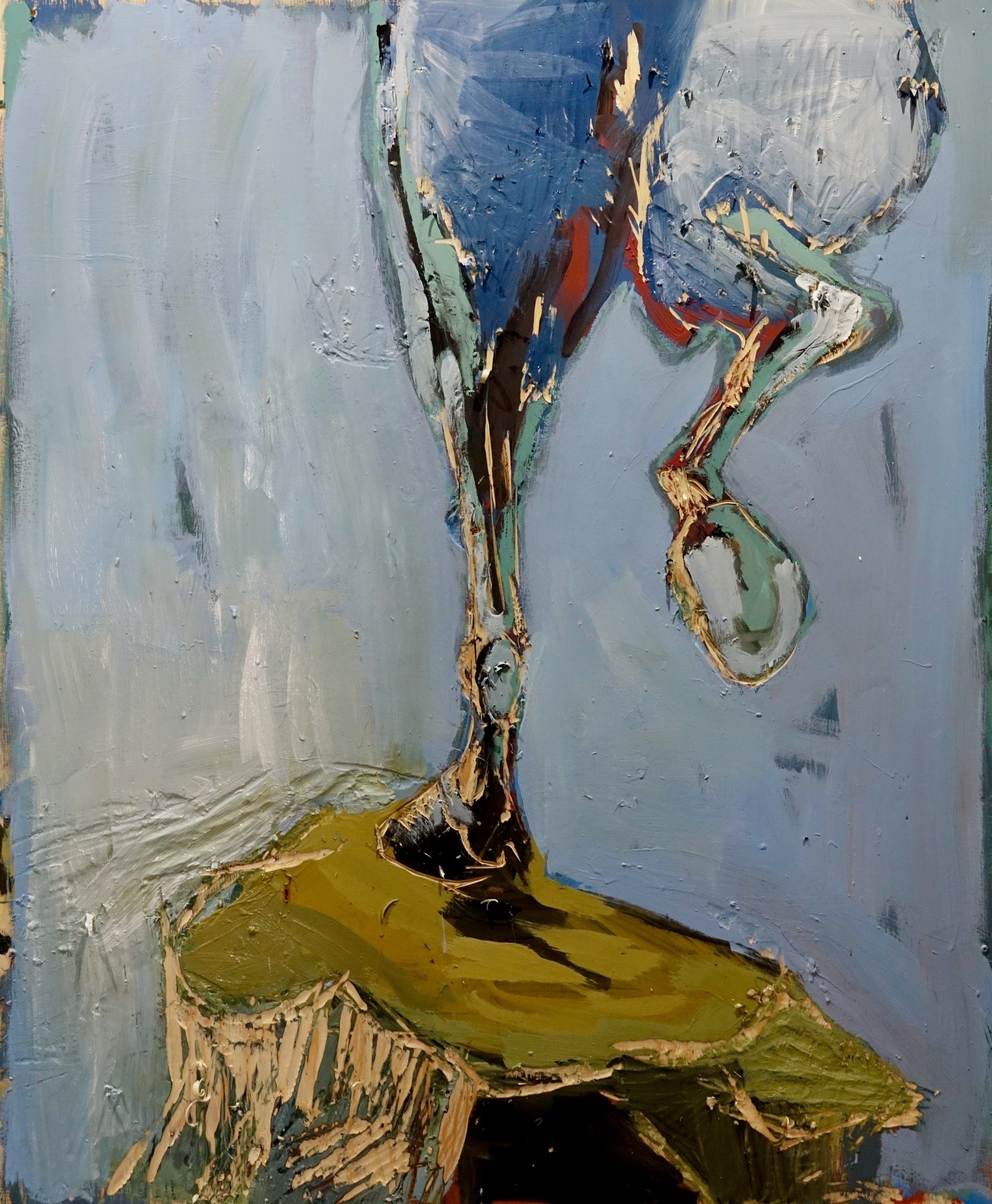09.07 – 11.07.2021
Booth V1
Palacio Neptuno, Madrid, Spain
Hélène Damville, Paul de Pignol, Olivier de Sagazan, and Cedric le Corf
Loo & Lou Gallery has the immense pleasure to announce our participation in the contemporary art fair JUSTMAD for the fourth year in a row.
Our proposal revolves around the universe of four French artists, who are painters, engravers, illustrators, and sculptors. This proposal honors the theme of the landscape as well as living matter, both animal and vegetal.
HÉLÈNE DAMVILLE

Born into a family of artists in Normandy, Hélène Damville has been practicing drawings inspired by nature since her youth. This passion for the observation of life (both fauna and flora) led her to explore the Natural History Museum of Paris where she discovered Buffon and the naturalists. Copying works by her teachers, she familiarized herself with the complexity of skeletons and their articulations, as well as the networks and ramifications of the plant world. These dry elements represent life’s architecture as well as the traces left by passed lives. Parallel to her assiduous visits to museums, she completed her studies by following artistic anatomy classes and graduating with a Masters in Oriental Philosophy from the Sorbonne. In this environment of scientific, philosophic, and artistic analysis, she built up her portfolio of etchings. The desire to be close to living matter pushed her to choose engraving as the main media in her research; Engraving, but more specifically directly carving on metal and wood. Through lines and vigorous strokes, the artist is able to translate the essence of life in her work. She was trained with a copper chisel by André Bongibault at the studio L’Estampe de Chaville, then later perfects ornamental engraving on metal at l’École Boulle. In her pieces, humans are rarely directly represented.
From engraving to tattooing
We find a natural extension in Damville’s pieces from working lines in the wood to the ancient art of tattooing. She is currently an apprentice in the Parisian tattoo salon belonging to Alessio Pariggiano. Since she loves working with organic material, Damville found the artistic niche she has been looking for.
From 2014 to 2015, she was an artist member of the French Academy in Madrid, Casa de Velazquez. In 2017, she won the Jean Asselbergs Prize, Taylor Foundation.
PAUL DE PIGNOL

Paul de Pignol was born in Toulouse in 1965. He currently lives and works in Paris. In 1984, he entered the National School of Fine Arts in Paris, where he worked in Pierre Carron’s painting studio. He created his first sculpture, inspired by the Venus of Lucas Cranach, entitled “Fille au Ballon” in 1989. Little by little, sculpting was integrated into his practice. In 2010, de Pignol decided to dedicate a specific workshop to drawing in Paris, establishing a link between the two disciplines a short time afterwards. Whether sculpting or drawing, de Pignol plunges into an intimate essence of the being. He focuses his work on feminine figures, linking them with universal themes of birth, life, and death. Throughout his study of the female figure, he began questioning its function, weight, and composition, as well as its deconstruction and presence both of the interior and exterior. De Pignol’s paintings are an extension of his work and research as a sculptor. His gestures are similar, wherein he erases matter in order to add light, stroke by stroke, giving his unravelling bodies a spectral presence. Since 2017, after years of failure, rejection, and wandering, de Pignol found pictorial language relative to his research. One of his recent exhibitions at Loo & Lou Gallery, Né du limon, is the result of this quest. With a fascination for landscapes, the artist is inspired by the Fontainebleau forest that surrounds his studio. The idea that any life can be birthed from decay fascinates him, and inspires him to create organic and living landscapes, where you can feel the turf and soil. We are close to Golem. This exhibition reunited for the first time drawings, sculptures, and canvases, in what represented for the artist a joyous and fertile renewal, thanks to both the subject matter and the use of multiple medias.
OLIVIER DE SAGAZAN

Born in 1959 at Brazzaville in Congo, Olivier de Sagazan lives and works in Saint-Nazaire. Trained as a biologist, he is interested in the living and, through his pieces, seeks to establish a sort of genealogy of the sensibility. He aims to better understand how, at some point, inert material structured by cells engenders life and sensitivity. For about 25 years, Olivier de Sagazan’s work has principally revolved around the human body. In parallel with his creations - paintings, sculptures, installations - de Sagazan produces performances, popularly seen by the entire world, during which he utilizes his own body as a mold, with clay and paint as his mediums. Converting his face and body, he manoeuvers through choreographed gestures, alloting for radical metamorphoses. The artist predominantly uses clay and plants that he gathers and kneads in order to create lifelike material. From these elements, a polymorphic world appears composed of different characters like a bestiary where humans intertwine with animals.
CEDRIC LE CORF

Cedric Le Corf was born in 1985 in Bühl, near Baden-Baden (Germany), he lives and works in Brittany, in the Morbihan region. He graduated in 2009 with honours from the École Européenne Supérieure d’Art de Bretagne in Lorient.
The anatomical landscapes inspired by Jacques Fabien Gautier d’Agoty’s boards have resurfaced over time as an inspiration for Le Corf’s work. Little by little, a dismembered man is transformed into a landscape of a man. Humans, trees, and the earth all possess a kind of “skin” and with it, the ability to be flayed. Is it not true that a dissected body is merely a wide range of landscapes, full of mishaps, folds, and crevices? The slightest roughness in bone is reminiscent to the rocky landscapes of Patinir; the venous, arterial, or nervous network irrigates like rivers, plains, and estuaries; muscles, like the clay of Genesis, model gorges and mounds.
Using this metaphor, he uses plant roots as a landscape element to interlock bones, vertebrae, or joints made of porcelain. The root, in its etymological sense, is one element implanted inside another, much like the root of a tooth, a hair, or the dorsal root. It thus opposes the raw element of chaos to the mastery of creation, from roughness to polish, from decomposition to the inalterable, from the durability of art to the ephemeral man.
Imbued with the Rhineland and Armorican heritage, confronted with the pathos of Grünewald (Baldung Grien), the hanged men within “Des misères de la guerre” by Jacques Callot at “l’Ankou,” along with the macabre dances of Kernascléden, where the animate and the inanimate are mixed, to the horror of the mass graves of Sobibor, Le Corf tries, by attaching himself to a motif, to deafen the subject that the sculpture, the painting, or the engraving contains.
He has done several artist residencies, including the Dufraine Foundation in Chars, Académie des Beaux-Arts 2016-2018, the Spitzberg Expedition Residency 2017, Member of the Casa Velasquez in Madrid 2018-2019, and the Miro Foundation in Palma de Mallorca 2019. He received the Georges Coulon Prize (sculpture) from the Institut de France, Académie des Beaux-Arts in 2017. He has participated in numerous solo and group exhibitions in France, Germany, Spain and Belgium. His work is included in numerous private collections (Yvon Lambert collection).




